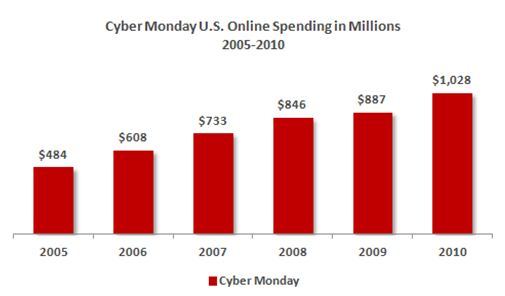From 2005 to 2010, Cyber Monday sales (the Monday after Thanksgiving) have more than doubled, as illustrated. A recent article from the Wall Street Journal showed an increase of 22% in sales on Cyber Monday in 2011, compared with the 2010 holiday season.
According to research firm Score, Inc., the 2011 holiday season saw a 15% increase in web sales over 2010, for a total of $35.5 billion in online sales (while overall holiday spending was up just 3.8% from 2010).
The holiday season is not just about selling products to your customers. It also involves keeping those that come for the first time, and keeping them there. As said by Jakob Nielsen, “It’s an old lesson: It’s much easier to close additional sales with existing customers than to acquire new customers. People who’ve proven willing to give you money will often give you more. This is true for all sales channels, but it’s particularly crucial for e-commerce because the first order proves your credibility if you effectively handle follow-up and delivery.”
The following statistics about shopping carts highlight how website usability problems can impact sales:
 21% of buyers said they “decided not to shop at any given site because of security concerns.” (Jan Riley)
21% of buyers said they “decided not to shop at any given site because of security concerns.” (Jan Riley)
 1 second delay in page response = 7% reduction in conversion (Sean Work)
1 second delay in page response = 7% reduction in conversion (Sean Work)
 54% of U.S. consumers believe companies are more interested in selling products and services (Michael Fisher)
54% of U.S. consumers believe companies are more interested in selling products and services (Michael Fisher)
According to Aaron Marcus, Staples.com® in applying usability in their website found:
- 67% more repeat customers
- 31-45% reduced drop-off rates
- 10% better shopping experience
- 80% increased traffic
 ½ of your potential sales are GONE if customers can’t find merchandise on your e-commerce site
½ of your potential sales are GONE if customers can’t find merchandise on your e-commerce site
“At HomePortfolio.com we monitored site traffic, observed consumers in usability studies and worked with internal business groups. This helped us make changes that made the site’s purpose clearer and increased transaction rates measurably. The change increased the traffic up 129% the week we put it up.” (Interaction Design, Inc., 2001)
Some issues to consider that cause shopping cart abandonment:
(Charles Nicholls) & (Roger McGershen)
- Customers abandon their shopping carts when the ratio of the shipping cost to the value of the cart approaches 100 percent. Would you buy a $19.99 item if it costs an additional $14.95 to ship?
- Customers are sensitive to perceived price points. $9.99 seems cheaper than a $10.00 item. The same idea goes for shipping costs and how many items are in a cart. One study found that a $99 minimum order to get free shipping encouraged people to add more items to their carts.
- Not able to find contact information (22% abandonment rate): trust is lost if a person has no way, or difficulty in finding, how to contact you.
Nine ways to improve shopping cart retention and visitor experience:
- Disclose shipping costs in advance.
- Show security icons.
- Create trust: Communicate your online store’s trustworthiness by having clear guarantees and contact information. Display company phone numbers on every page, along with hours of business, and place your guarantee and return policies prominently.
- Easy shopping cart return: make it easy for customers to return to the shopping cart without having to go back through the purchase process.
- Offer comparison shopping directly from your site.
- Offer coupons and discounts.
- Encourage user reviews and reward those customers who give them.
- Do not have a graphic heavy page.
- Make contact information prominent throughout your site.
When going over the final numbers of your holiday sales, consider the facts presented in this article. Consider how your potential customers view and interact with your e-commerce website. Review your weblogs and customer comments. Work with your hosting company and see how many shopping carts were abandoned. Most importantly, review the usability of your website.
As Jakob Nielsen said, “Usability rules the Web. Simply stated, if the customer can’t find a product, then he or she will not buy it.”
If you would like some assistance with reviewing your website’s usability, please contact CueCamp.
Written and Posted by: CueCamp




Malcom Mady
Hmm it seems like your blog ate my first comment (it was super long) so I guess I’ll just sum it up what I wrote and say, I’m thoroughly enjoying your blog. I as well am an aspiring blog writer but I’m still new to the whole thing. Do you have any tips for first-time blog writers? I’d certainly appreciate it.
Matthew Sharritt, Ph.D.
I’d say it’s all about posting regularly, integrating social media, and maintaining a quality theme in your posts. Best of luck!